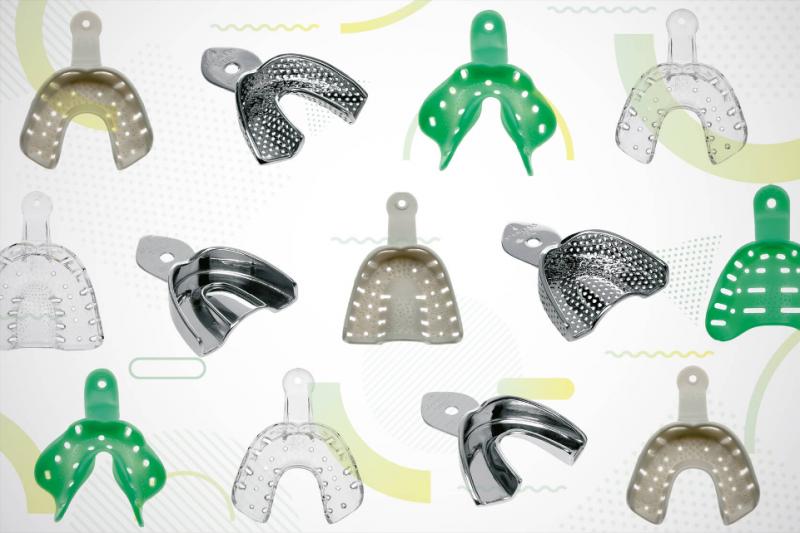Dental Impressions: the Different Types of Impression Tray

The fundamental instruments of a dental practice undeniably include the accessories for taking dental impressions, an essential yet delicate step. As we all know, this operation is carried out using an impression tray, a special container inside which the impression material needed to obtain a negative copy of the patient’s teeth is arranged. Given the presence of both anatomical differences and different impression materials, it is necessary to choose the impression tray best suited to the specific case: we will now look at the main types dentists can choose from.
Custom impression trays
As mentioned previously, the impression tray is the fundamental starting point for any indirect rehabilitation. Generally speaking, all impression trays have a common structure, consisting in the flanges, floor and handle. However, the dimensions, materials used and type of development vary. More specifically, these accessories for impression-taking can be split into two main groups: on the one hand, individual or custom-made devices; on the other, ready-made devices with standard dimensions and arch shapes.
Custom impression trays are made-to-measure, in order to accurately reflect the patient’s anatomy. Nevertheless, there are different types of custom impression trays. The models made using the conventional technique, on spaced gypsum models, are made of resin by means of a curing process. Less common, but nevertheless used, is the digital process, in which the impression trays are created with CAD/CAM technology and made using PLA, polylactic acid, by means of 3D printing.
One of the drawbacks of custom impression trays is that, with the exception of models in which holes have been drilled, they provide the impression material with no mechanical retention. Therefore, before using these devices to take dental impressions, the dentist must apply a special adhesive to the impression tray to favour adhesion between the impression material and the floor, and which is chosen according to the device and the material used. With 40 years’ experience in the development of solutions for the dental sector, Zhermack manufactures adhesives that have been specifically developed for different types of impression tray, to eliminate the risk of the device and polyvinylsiloxanes separating.
Ready-made impression trays
As we have already seen, impression trays are not just custom-made, and ready-made impression trays are available on the market. These impression-taking devices typically come in 6 different sizes and they can either cover the whole arch or be designed to cover a semi-arch or a specific section of the arch.
The ready-made impression trays available on the market include both metal and plastic models. In this latter case, the devices are disposable and can be drilled to provide greater mechanical retention. It is important to remember that the plastic impression trays available on the market also include dual-arch models that make it possible to record both the arch of interest and the antagonist arch in a single process.
The advantage of metal impression trays over the plastic ones described previously consists in their greater rigidity, which makes it possible to obtain a more accurate and precise impression. Metal impression trays can be perforated or non-perforated and come with or without retention rim. As perforated trays with retention rims offer excellent mechanical retention, the impression material undergoes only minor distortion; however, they have the disadvantage that if the material comes out through the holes, it partially compromises the pressure exerted when taking the impression. This is not the case for impression trays without holes or rims, but these models require a dedicated adhesive.
When treating edentulous patients, Schreinmakers metal impression trays, which are available on the market with different arch shapes and various sizes, can be a valid option. These are devices whose shape and flanges have been designed specifically to suit the particular anatomical characteristics of patients missing several teeth: in order to be sure to choose the correct size, intraoral measurements can be taken using a special compass.
Choosing the impression tray that best suits the specific case, according to the material used and the anatomy of the patient, is a step of crucial importance, as it is the only way to be sure to take a precise impression, by reducing mucosal compression, on the one hand, and the deformation of the material used, on the other. Based on this assumption, the practitioner will be able to fabricate a prosthesis that satisfies the particular characteristics and requirements of each patient.
More to Read:
Previous Posts:





